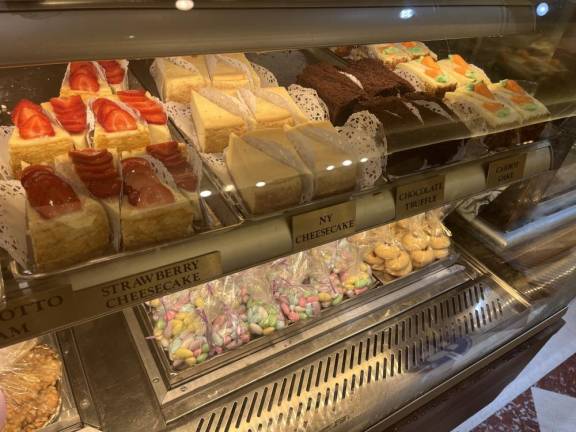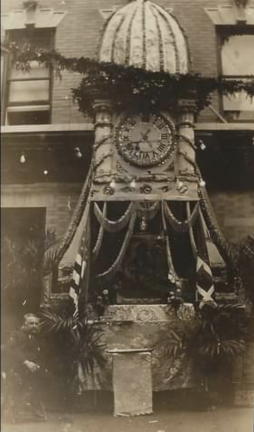Little Italy Prepares for Feast of San Gennaro
Manhattan neighborhood readies for the 96th annual block party
This year marks the 96th annual Feast of San Gennaro in Manhattan’s Little Italy, which will run from Thursday, September 15 to Sunday, September 25.
The festival features the best that Little Italy has to offer, from food vendors to competitions to rides and parades. Every year, a prominent Italian-American serves as “Grand Marshal” of the festival; this year’s Grand Marshal is NASA astronaut Michael Massimino.
Originally just a day long, the block party grew to an eleven-day festival that is now about to celebrate its 96th birthday.
Important Symbol
San Gennaro, the patron saint of the city of Naples, has long been an important symbol in Manhattan’s Little Italy. The enclave was first settled in the 1860s by Italian immigrants from several regions, notably Campania (where Naples is located) and Sicily.
Though Italy did not exist as a unified nation until 1861, immigrants from the peninsula began to arrive in New York even before then, fleeing poverty and violence in the Old World. In the following decades, hundreds of thousands of their countrymen followed their lead and set sail for “L’America.”
After passing through Ellis Island, the first wave of Italian immigrants settled in the blocks around Mulberry Street. The regional diversity for which Italy is famous was replicated here in the New World; Northern Italians settled around Bleecker Street, while Sicilian immigrants stayed on Elizabeth Street. By the 1930s, the neighborhood was 98% Italian.
Today, many of the descendants of those original immigrants have moved out of the neighborhood and into other areas such as Staten Island, New Jersey and Long Island. However, Little Italy is still one of Manhattan’s most beloved ethnic enclaves and a tourist destination known for its food, vendors and lively spirit. And for those Italian-American residents who remain, the Feast of San Gennaro is an important way of keeping their culture alive and sharing it with other New Yorkers and tourists alike.
Vivian Catenaccio, president of the organization Figli Di San Gennaro (“Children of San Gennaro”), has been involved with the festival her entire life.
“My grandfather was one of the original founders of this feast [in the US],” says Catenaccio. “So I’ve been in it since then.”
She says the neighborhood remains very close-knit. “We’re still a community,” she says, explaining that although the neighborhood has changed over the years, nearly everyone who lives within its central three blocks knows each other.
A Bakery Steeped in Tradition
Ernest Lepore, president of Ferrara’s Café, is busily preparing for the Feast a week in advance. Located at 195 Grand Street, the bakery is well over a hundred years old and will sell and give away its famous cannoli — plus myriad other baked goods — at the Feast. It also sponsors the festival’s famous cannoli-eating contest.
A week before the Feast is due to begin, the kitchen in Ferrara’s bustles with activity. Food, of course, is a central component of the San Gennaro festivities. At Ferrara’s, everything is made from scratch. Unlike many Italian bakeries in the U.S., Ferrara’s owners are proud to say they make their own cannoli shells rather than using premade ones; they then fill each with two dollops of their homemade cannoli cream.
“I could [fill] 600 an hour,” says Lepore proudly as he energetically pipes cream into the cannoli shells. “A good man could do 800 an hour.”
“One of the things I love about the Feast is that everyone comes together for a good time,” says Lepore. “In this crazy, wacky world, we come together and enjoy.”
The bakery, like the rest of Little Italy, is steeped in tradition. Lepore says he is the fourth generation of his family to run Ferrara’s, and hopes the next generation will continue his work.
“We were here since at least 1887,” he says, “incorporated in 1892.” He points out appliances in Ferrara’s kitchen, several of which date back to the 1920s.
In the early days of Little Italy, he says, “People came to Ferrara’s to gather. It was very much a social gathering space, [whether] you were an accountant or you laid bricks.” Today, it is still a thriving business and remains an important part of the neighborhood’s history.
The Miracle of San Gennaro
The festival still retains its original, religious significance. The festival kicks off with a procession of a statue of San Gennaro through the neighborhood. At the end, the statue will come to rest in a chapel where it may be viewed.
“[San Gennaro]’s last miracle was praying for divine intervention that the Vesuvius didn’t blow,” Lepore explains. In the city of Naples, priests still perform an annual ritual on the Feast of San Gennaro (September 19) in which they retrieve a preserved vial of the 3rd-century saint’s dried blood and observe it liquify before a crowd of the faithful. According to Neapolitan legend, if it fails to liquify, bad luck is likely to befall the city.
What to Expect This Year
Catenaccio says spirits are high in anticipation of this year’s feast. In 2020, the festival was canceled due to the COVID-19 pandemic. In 2021, the festival was held but with some restrictions.
“We’re very excited because last year was sort of questionable,” she explains. “We decided to have the feast [last year], but the pandemic was still lingering.”
However, she says, “It turned out to be very, very successful, and we hope that this year it’s going to be just as good.”
On Monday, September 9/19 at 6 p.m., a Solemn High Mass will be celebrated at the Shrine Church of the Most Precious Blood (entrance at 113 Baxter Street) in honor of the patron saint. Tuesday 9/20 at 7 p.m. will be the 17th Annual Enrico Caruso Opera Night. A full calendar of the San Gennaro festivities may be found at https://sangennaronyc.org/event-calendar/.


